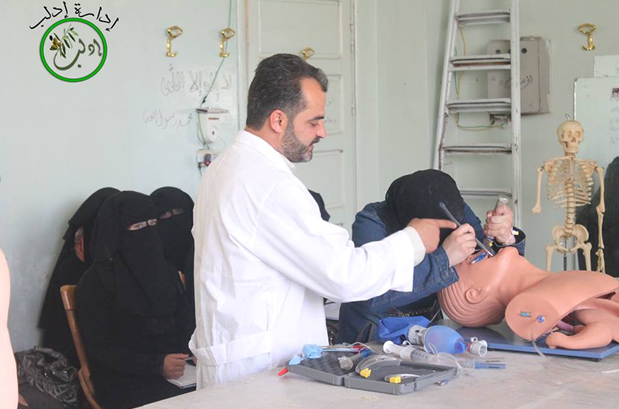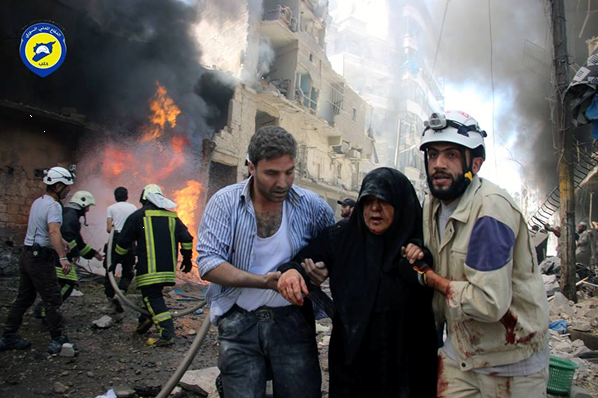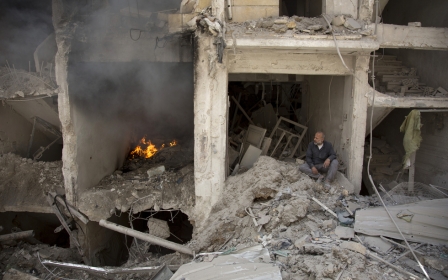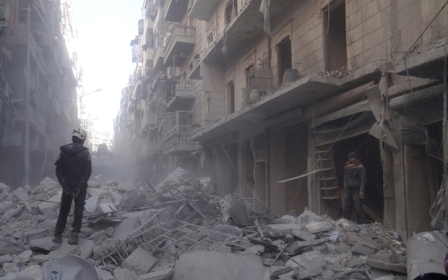More Syrians dying from preventable illnesses than bombs

By Noura Hourani, Maher al-Hamdan and Maria Nelson
AMMAN - It took Umm Omar two hours to die.
The 25-year-old mother of three, a resident of Syria’s northern, rebel-held Idlib province, was suffering from Guillan-Barre syndrome (GBS), a rare disorder in which a person’s immune system attacks their peripheral nerves, causing progressive loss of sensation and paralysis.
A few months ago, Umm Omar was having trouble breathing. Her respiratory system was failing and she was rushed to the hospital in her town of Saraqeb, about 14km southeast of Idlib city.
She needed a mechanical ventilator to keep breathing. Saraqeb’s hospital didn’t have one available, so there was nothing they could do. She struggled for air for two hours before dying.
Umm Omar’s doctor said if the hospital had standard medical equipment such as ventilators, she would probably be alive today.
“Simple cases like these, in which patients could easily be saved, are losing their lives because of the shortage of basic medical devices,” Dr. Qasi al-Kanani, who works at the Saraqeb hospital, told Syria Direct. “We couldn’t save her.”
Today, two-thirds of Syria’s public hospitals are partially or completely destroyed.
The Syrian American Medical Society (SAMS) estimates that at least 200,000 civilians have died from non-communicable chronic diseases including diabetes and cancer during the war, making up a significant portion of 470,000 Syrians thought to have died so far.
Doctors inside Syria say that under-equipped hospitals and a lack of medical professionals, a result of the war and sieges on cities and towns, are killing as many or more Syrians than the actual fighting.
“The number of people killed by different illnesses outnumbers those killed by bombardment,” Jawad Abu Hatab, the newly elected president of the opposition National Coalition for Syrian Revolutionary and Opposition Forces, who is also a doctor based in Syria, told Syria Direct in a recent interview.
“We have two million people suffering from high blood pressure in Syria,” said Abu Hatab. “Only 30 percent of them are receiving treatment.”
“Every year, we have 8,000 people die from heart attacks alone,” he added.
Since the war began, the average life expectancy in Syria has plummeted by nearly 20 years, “from 70.5 years in 2010 to an estimated 55.4 years in 2015”, the Damascus-based Syrian Center for Policy Research reported this past February.
“There’s no chemotherapy for people with cancer,” Khaled, a resident of one pro-government Idlib town blockaded by rebel forces told Syria Direct last month. “Even if there were, there’s nobody to oversee the treatment.”
Shortages of fuel and electricity cuts mean no power for medical devices and no refrigeration to preserve vital supplies such as insulin.
“Even if you find insulin here, it’s been damaged,” said Khaled. “Deaths and amputations have been recorded from hyperglycemia.”
Without a functioning medical infrastructure, diseases such as polio, measles, typhoid and tuberculosis are making a comeback in Syria, most markedly in encircled areas to which warring parties routinely block the delivery of medical aid.
One in three Syrian children can’t be reached with needed vaccines, said the WHO in its 2016 Humanitarian Response Plan for Syria, published at the end of last year.
Compounding the lack of medicine, supplies and vaccines, thousands of doctors have fled Syria over the past five years.
Compounding the lack of medicine, supplies and vaccines, thousands of doctors have fled Syria over the past five years. Between 2011 and 2013, about 15,000 Syrian health professionals left the country, according to Physicians for Human Rights. In other words, half of Syria’s registered physicians left over a span of two years.
Hundreds of others have been killed. In November 2015, Physicians for Human Rights reported that 687 medical personnel had been killed in Syria, while ongoing attacks on medical facilities—the overwhelming majority carried out by government forces—mean that number continues to increase.
“There’s a huge lack of medical personnel” in 90 percent of rebel-held areas, SNC president and medical doctor Abu Hatab told Syria Direct. Nurse technicians and obstetricians are in particularly short supply, as are anesthesiologists.
In an effort to fill that gap, the Medical Institute at Idlib University - established by the opposition interim government and not recognised internationally or by Syrian President Bashar al-Assad - is currently training hundreds of students to work as medical personnel inside rebel-held Syria.
Some 300 Idlib students are currently completing their coursework for a two-year degree in anesthesiology, with the two other options being obstetrics and emergency medicine.
“The graduates will be a big support for the medical sector in rebel-held areas,” said al-Kanani, the Idlib doctor who is also a lecturer at the Idlib institute. “Anesthesiologists have a big role in our hospitals, with the large number of war injuries.”
The school aims to “make up for our current shortage of anesthesiology technicians following the death or emigration of many doctors and personnel,” he added.
Two years of training for nurses and other non-doctor medical personnel is standard in Syria, while doctors study for five years before residency. However, in wartime Idlib, those two years of study are in underequipped classrooms and do not include real-world experience.
“The teaching staff focuses on theoretical lessons, not the practical skills that are the basis of the medical field,” Salam al-Ahmad, an anesthesiology student at the Idlib Medical Institute told Syria Direct. “The lab should be better and more broadly equipped.”
“We’re accepting anesthesiology assistants as anesthesiologists because we don’t have any other solution,” Abu Hatab told Syria Direct.
“We aren’t waiting for anything from the international community,” said Abu Hatab, adding that material support for doctors in Syria has declined in recent years.
“They just condemn, watch and witness our tragedy. We’ll depend on ourselves and our own personnel.”
Syria Direct is a non-profit journalism organization that focuses on coverage of Syria
New MEE newsletter: Jerusalem Dispatch
Sign up to get the latest insights and analysis on Israel-Palestine, alongside Turkey Unpacked and other MEE newsletters
Middle East Eye delivers independent and unrivalled coverage and analysis of the Middle East, North Africa and beyond. To learn more about republishing this content and the associated fees, please fill out this form. More about MEE can be found here.





